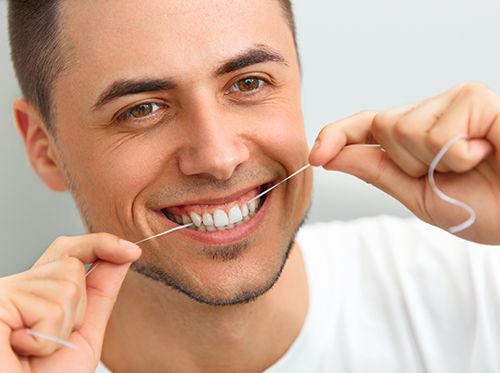Dental Emergencies in Children
April 25th, 2023

Dental emergencies are bound to come up when you have young children. Drs. Angela Paros, Amer Atassi, Eric Young, Alexander Katsnelson and our team want to you to be prepared in case you run into a difficult situation. Problems can vary, from minor gum irritation to knocked-out teeth. Take a look at the different possibilities and how you can handle them.
Teething
Depending on the age of your child, there are common things to watch for when it comes to his or her teeth. Starting from a young age, your son or daughter may experience teething pain. This starts at about four months and can last up to three years.
Teething may cause your little one to become irritable and more prone to drooling due to tender gums. This is very common in young children who are teething, and can be alleviated by giving them a cold teething ring or by rubbing their gums with your finger.
Teething pain is as normal as your child’s first set of teeth falling out. On the other hand, if a baby tooth is knocked out in a forceful accident, make sure you bring him or her into our Romeoville, IL office to check that other damage hasn’t occurred in the mouth. On occasion, permanent teeth may grow in before baby teeth have fallen out. This may not cause any discomfort, but Drs. Angela Paros, Amer Atassi, Eric Young, Alexander Katsnelson should make sure the teeth are growing in properly. Catching teeth that are coming in incorrectly can prevent issues from arising in adulthood.
Gum Issues
If you’ve noticed your child’s gums bleeding often, this could result from a number of things. Bleeding gums may be an early sign of periodontal disease, which is caused by poor oral hygiene when it appears in children. Excessive gum bleeding can also occur when children brush their teeth too hard, or suffer an injury to their gum tissue.
If bleeding is continuous, rinse your child’s mouth with warm salt water and apply light pressure to the area. If you become concerned about the amount of blood, contact our Romeoville, IL office and we will schedule an appointment for your youngster as soon as possible.
Depending on what type of dental issue your child is experiencing, you should make sure to treat it quickly and properly. If you have questions or concerns about what you can do to help your son or daughter develop better oral hygiene habits, ask Drs. Angela Paros, Amer Atassi, Eric Young, Alexander Katsnelson for tips during your next appointment.
Don’t forget: As a parent, you can provide the best education to your children on the importance of proper oral hygiene by setting a good example.
How Sedation Dentistry Can Help You Overcome Dental Anxiety
April 24th, 2023

Sometimes people feel a tiny bit nervous when they sit in the dental chair. And sometimes it’s more than a tiny bit. If your anxiety over visiting the office leads you to skip regular checkups and cleanings, or, worse, if you would rather suffer tooth or gum pain than give us a call—give our Romeoville, IL office a call! Sedation dentistry might be just the procedure you need to make dental anxiety a thing of the past.
Drs. Angela Paros, Amer Atassi, Eric Young, Alexander Katsnelson and our team are trained to administer sedation and to monitor your responses throughout. And we want you to have all the information you need to decide on any dental treatment, including sedation. We will tell you of any risks, and describe the procedure in detail. If you have any health conditions or take any medications that might interfere with sedation, we can discuss your options with you and your doctor to make sure you are a good candidate. We will explain any preparations you should take, and let you know if there is a window of recovery time needed in our office while the sedation wears off.
Don’t let yourself suffer dental pain because you suffer from dental anxiety! Please call us to discuss sedation. We are trained to administer the treatment you choose gently and safely. Above all, we want to help you keep your smile the heathiest it can be, and that only happens when you have regular dental care. Let us work with you to make that care as comfortable and stress-free as possible.
How many times a day should I floss?
April 24th, 2023

Flossing is one of the most important parts of your oral care routine. Many patients know they need to do it but find it difficult to fit into their busy lives. Well, here's the good news: flossing once a day is enough if you're doing a good job!
Some patients like to brush before they floss and others like to floss before they brush. Some like to floss in the morning when they have more energy, others like to floss at night so they can go to bed with a clean mouth. Don't get hung up on any of this, the important thing is that you floss and floss effectively no matter when you do it.
Effective flossing contributes to oral health in these ways:
- It reduces the chance of cavities between teeth, since cavities can only form on teeth covered with dental plaque and you're scraping that plaque away when you floss.
- Along with brushing, it reduces the amount of time the plaque is left on your teeth, allowing them to be in a state of healing and remineralization for longer.
- It removes plaque that accumulates at or below the gum line, aiding in the prevention of gum disease.
As you can see, flossing offers many benefits for such a simple and inexpensive technique. So if you're still wondering how much to floss, don't worry about it. Don't mistake the frequency of your flossing with the effectiveness of it. Choose a dental floss that you like and one time during the day when you can floss thoroughly and just do it! If you need more tips on how to floss correctly, ask Drs. Angela Paros, Amer Atassi, Eric Young, Alexander Katsnelson or any member of our Romeoville, IL team—we'd be glad to help you pick up this healthy habit!
Top Ten Ways to Improve Heart Health
April 5th, 2023

The human heart truly appreciates it when we eat healthy foods, don’t smoke, and exercise regularly. But there’s something else that can improve your heart’s longevity and you may not know about: keeping your teeth and gums in tip-top shape.
Bacteria responsible for periodontal disease have been found in the heart area of subjects who suffer from artery inflammation, high cholesterol, and heart disease. Physicians and dentists, like Drs. Angela Paros, Amer Atassi, Eric Young, Alexander Katsnelson, think that it is not difficult for oral bacteria to enter the bloodstream through diseased, bleeding gums, and abscesses that reach from the gums into veins and capillaries that carry blood to and from the heart.
In addition to practicing good oral hygiene and visiting High Point Dental Group every six months, here are ten other ways you can make your heart love you for the rest of your life:
- Avoid eating foods that contain saturated fat (fatty meats, processed meats, pastries, butter).
- Craving a crunchy snack? Grab a handful of tree nuts: pecans, almonds, walnuts. They’re rich in monounsaturated fats (the “good” kind of fat) as well as vitamin E, magnesium, and potassium.
- Eating a bowl of oatmeal for breakfast nourishes your heart with a soluble fiber called beta-glucan that can reduce cholesterol and help prevent atherosclerosis.
- Think “fish” the next time you shop for groceries, especially sardines, salmon, fresh tuna, and mackerel. These fish provide omega-3 fatty acids that lower triglycerides and blood pressure, and may help prevent blood clots from forming.
- Opt for whole grains over processed white breads and cereals.
- Put that remote control (or computer mouse) down right now and get moving! Walk, swim, ride a bike, plant flowers; your heart likes to pump, so make it pump.
- Refresh your brain and improve your heart health with at least eight hours of sleep every night.
- De-stress your life as much as possible: relax, stay optimistic, and don’t sweat the petty stuff!
- Watch your weight and get regular health examinations, especially if you have a family history of heart disease.
- And don’t forget to brush, floss, and rinse twice a day!






